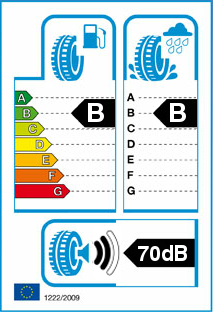Choosing the right tires for a car seems to be a complicated matter for many of us. Not everyone has to have the same knowledge, which is why we present you a guide that can help you choose the right tires for your car.
Where to start, i.e. we check what we have on our wheels?
Choosing the right tires should start with checking the size of the tires that are mounted on our vehicle. The tire size is stamped on the sidewall of each tire. In the case of passenger cars, in most off-road vehicles and vans, the size is given in the following form: 205/55R16, where 205 means the width of the tread in millimeters, and 55 the height of the profile (side) of the tire as a percentage of the width. In this case, it is 55% of 205 mm. The last important parameter is the diameter - 16 inches. Please note that while we can fit tires wider or narrower than the nominal size, as well as taller or lower, we cannot change the diameter. A 16-inch tire is mounted on a "16" rim, a 15-inch tire on a "15" rim, and so on. The sizes of tires and rims that can be fitted to our car can be found on the inside of the fuel filler, door sill or in online tire and rim catalogs. As far as possible for normal operation, it is not recommended to change the original tire size, unless we want to achieve some intended goal, e.g. "raise" the height of the car so that it does not hit speed bumps.
All-season or seasonal tires?
If we know the tire size, we must decide whether we want to buy seasonal tires (summer or winter) or all-season tires. Having one set of all-season tires will save a lot of money, but we must bear in mind that an all-season tire will never be better than a winter tire in winter, and a summer tire in summer. It is a compromise between safety and economic factors. If the car is used daily, it is recommended to have two sets of tires.
What brand and what tread, i.e. a tire for every occasion, how to read offers.
Once we choose the size and know what type of tire we want to buy, we can start looking for the brand and model. Of course, it is not easy to choose from over 100 available brands and several hundred types of treads.Tires can be divided into three segments:
- Premium class – these are branded tires characterized by the highest driving parameters. Representatives include Michelin, Continental, Pirelli, Dunlop. Particularly noteworthy is the Vredestein brand, which designs its tires together with the world-famous Italian automotive stylist - Gugiaro.
- Medium Class – these are branded tires characterized by the best quality-to-price ratio. Representatives include Firestone, Uniroyal, Fulda, Kleber, Falken. Particularly noteworthy is the Korean brand Hankook, whose products have achieved very good results in tire tests in recent years.
- Economy class - these are cheap tires that are a compromise between performance and price. Representatives are Barum, Dębica, Kormoran, Dayton, Sava. Particularly noteworthy are Nexen tires, which, despite the low price, are characterized by good performance.
However, it should be remembered that the brand is not everything. Of course, it can be synonymous with high quality, but when choosing tyres, special attention should be paid to driving parameters. The top 3 are listed on product labels.
Fuel saving.
Class A tire is the most economical tire (lower rolling resistance) and G class tire is the least economical (higher rolling resistance). The level of rolling resistance affects the car's emissions and fuel consumption. Greater rolling resistance results in higher fuel consumption and emissions.
Wet braking.
The A-class tire has the shortest braking distance and the G-class tire has the longest braking distance. The higher the value of this parameter, the better the grip on a wet surface and the higher the level of safety.
Noise level.
The noise level of an approaching car is indicated by waves. 1 wave means a quiet tire and 3 waves means a loud tire. In addition, the label contains information about the level of emitted noise in decibels. The lower the generated noise level, the greater the travel comfort.
When looking for tires, it is worth determining the maximum budget we want to spend on them, and then finding a model that will be characterized by the best possible parameters.
I hope that our short guide will be helpful in choosing tires.
If you have any questions about choosing the right tires, please contact karol.kowalczuk@ distripark.com .
Karol Kowalczuk
High-quality car chemicals available at distripark.com
![]()
*This article is for informational purposes only. The presented description, in particular the use of the products, is exemplary and constitutes non-binding information about the characteristics and possibilities of their use/application. In any case, before using the product, consult a specialist whether the specific use is safe and justified. We do not bear any responsibility for the use of the proposed solutions, even in very similar situations.

